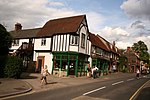Dunton Green

Dunton Green is a small village and civil parish in the Sevenoaks District of Kent, England. It lies in the valley of the River Darent, 3 miles (4.8 km) north of the town of Sevenoaks. Dunton Green is designated as being part of the Kent Downs area of outstanding natural beauty, due to its proximity to the North Downs. The original ecclesiastical church parish of Dunton Green was part of Otford parish. The former parish church was dedicated to St John the Divine. From at least the 17th century, Dunton Green was a centre for making bricks and tiles. In 1862, the Dunton Green Brick, Tile and Pottery Works was established: a large concern with clayholes or pits, kilns and an engine house. While clay was being dug for, many fossils were discovered.
Excerpt from the Wikipedia article Dunton Green (License: CC BY-SA 3.0, Authors, Images).Dunton Green
Station Approach,
Geographical coordinates (GPS) Address Website Nearby Places Show on map
Geographical coordinates (GPS)
| Latitude | Longitude |
|---|---|
| N 51.29648 ° | E 0.1716 ° |
Address
Dunton Green
Station Approach
TN13 2XD , Dunton Green
England, United Kingdom
Open on Google Maps







